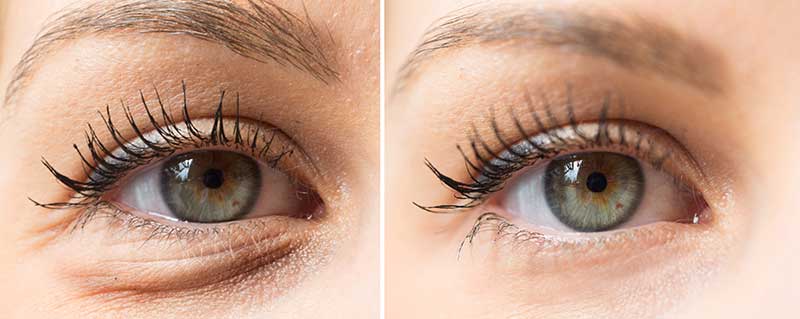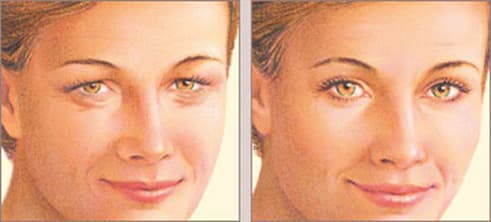
The goal of an “eyelift” or blepharoplasty is to recreate the natural contours of a youthful, rested eyelid, in eyes that have developed skin excess, bags, or drooping secondary to senescence (aging), genetic predisposition, or accelerated photo-aging.
Blephoroplasty Overview
Blepharoplasty is the comprehensive terminology for the description of eyelid rejuvenation surgical procedures. These include:
Upper Blepharoplasty (upper eyelid)
- Removes the excess upper eyelid skin
- The incision follows the natural crease of the eyelid, and upon healing, the scar is virtually undetectable
- Often performed with concomitant fat resection or fat transfer to volumize the peri-orbital and return youthful fullness
Lower Blepharoplasty (lower eyelid, outside)
- Removes the excess lower eyelid skin and fat pockets
- Often performed with fat resection to correct under-eye bags or injectable dermal fillers to correct hollowing or tear trough deformities
Lower Eyelid “Skin Pinch” Blepharoplasty
- Removes the excess lower eyelid skin
- Does not remove fat
- The incision follows the lower lash line, and upon healing, the scar is virtually invisible
Transconjunctival Blepharoplasty
- Removes fat, and skin when necessary, to treat pseudo-herniation of fat bags around the eye
It is important to note that blepharoplasty cannot lighten dark under-eye circles, eliminate lower eyelid fine wrinkles, or diminish or eliminate crow’s feet.
Procedure Walk-Through
- Preparation: During the pre-operative consultation, Dr. Vallecillos will assess your eyes and review your medical history. Please bring the following to your consult:
- Results of any recent eye tests from your ophthalmologist
- Contact lenses or glasses if you wear them
- Relevant health records related to the conditions above.
To prepare for blepharoplasty, you should discontinue the use of blood-thinning vitamins, herbs, and medications for two weeks before the surgery. If you smoke cigarettes, you should quit for at least two weeks before and after surgery. If you are over the age of 45, medical clearance by an independent physician may be required before undergoing surgery.
- Anesthesia: Depending on the type(s) of procedures being performed, a local anesthetic, IV sedation, or a general anesthetic will be administered.
- Enormous strides have been made in blepharoplasty, with a trend towards conservatism. Excess fat is carefully resected and in appropriate cases, repositioned throughout the eye to impart a youthful fullness to the eye. Muscle is typically spared, avoiding dated techniques that left patients with an inanimate, unnatural expression. In general, the procedure lasts anywhere from 45 minutes to two hours. Often, patients who present with sagging over the eyelids in fact need a brow lift instead of blepharoplasty. Brow lifts are almost exclusively performed by an endoscopic approach, allowing for minimal incisions and precise repositioning of the brow to its more youthful state. Several ancillary procedures exist that can augment the results of your blepharoplasty. Dr. Vallecillos will discuss beforehand which option is best for you, given your specific diagnosis and circumstances. Some of the more commonly performed eyelid procedures are as follows:

Tear Trough Management with Fat Transfer
Through senescence or aging, the peri-orbital area can lose volume, creating a hollowed look. Additionally, mid-face descent leads to the development of prominent naso-jugal folds. To correct this, fat transfer may be performed in conjunction with the upper and/or lower eyelift procedure, thus eradicating the hollowing and eyelid/cheek delineation of aging. An added benefit is an improvement of lower eye dark circles as well, which is secondarily supplemented with IPL Treatments.
book online
Lateral Canthal Suspension Technique
The goal of these techniques is to strengthen the structural elements of the outer corner of the eyelids (lateral canthus) hence lending to better support of the lower eyelid. These eyelid suspension techniques employ various specific sub-procedures, depending on the precise nature and requirements of the particular eyelid. They include canthopexy, canthoplasty, tarsal strip resuspension, inferior and lateral retinacular suspension techniques. Canthoplasty and canthopexy procedures are often times described interchangeably by surgeons, but are entirely different in their indication and nature.
A Canthoplasty procedure reinforces the lower eyelid support by detaching the lateral canthal tendon from the orbital bone and reconstructing it. Conversely, a Canthopexy procedure is much less invasive and essentially stabilizes the existing lateral canthal tendon without removing it from its normal anatomic attachment. In rare and severe cases, as with significant lower eyelid retraction (ectropion), a concomitant midface lift may be recommended to lend to caudal support of the lower eyelid. In these cases, insurance coverage may be possible, depending on the carrier, especially if the patient is at risk for dry eye syndrome or keratoconjunctivitis secondary to profound lower eyelid retraction.
From an aesthetic standpoint, these procedures are employed to correct an unappealing lower eyelid shape, such as an overly round eyelid shape, a pulled down eyelid (ectropion) or a sagging lower eyelid with too much “white” of the eyeball showing (scleral show). These eyelid problems may be resultant of the previous eyelid or midface surgery, senescence, and other hereditary factors.
Botox Injections are often performed in the peri-orbital rejuvenation to shape and lift the brow, minimize crow’s feet, and soften under-eye wrinkles. Fractionated Laser or IPL Rejuvenationis routinely utilized by Dr. Vallecillos in conjunction with eyelid rejuvenation procedures to add to the overall effect of the result. In fact, in most cases, Lumenis Total FX peri-orbital resurfacing is included in the eyelid lift procedures, allowing for superior results.
We also offer Asian Eyelid Surgery a procedure that creates a pretarsal crease in upper eyelids.
Frequently Asked Questions
What is eyelid surgery or blepharoplasty?
Blepharoplasty is a surgical procedure to remove skin and tissue from the eyelid areas. As skin loses elasticity, eyebrows sag, eyelids droop, and bags form under the eyes. Eyelid surgery permanently removes these signs of aging, providing immediate anti-aging results.
What is a good age for blepharoplasty?
For healthy adults seeking surgical eyelid procedures to improve signs of aging, blepharoplasty is usually performed after 40. By middle age, the skin has begun sagging and drooping due to reduced elasticity. Blepharoplasty provides lasting results no matter the client’s age.
What is laser blepharoplasty?
Laser blepharoplasty is a procedure that uses laser incisions to remove excess skin that contributes to unwanted signs of aging. Traditional eyelid surgeries use a scalpel to make the incisions. Incisions made with lasers cauterize as they cut, reducing the risk of blood loss, bruising, and scarring.
What is the best age to have an upper blepharoplasty?
Although most upper blepharoplasty patients seek treatment after age 40, healthy individuals of any age can safely undergo this cosmetic operation with no age-related risks or limits. Upper blepharoplasty procedures provide dramatic results for any client with excess skin.
Will an upper blepharoplasty get rid of the deep lines on the sides of my eyes?
Blepharoplasty is a surgical eyelid procedure that removes excess tissue from the upper or lower eyelids. These surgical techniques won’t cause any changes to lines or wrinkles around the eyes. Clients who want to reduce deep lines and wrinkles should ask their provider about injectable filler options.
What are the risks of double eyelid surgery (blepharoplasty)?
The risks of double eyelid surgery are minimal and are not any higher than a single eyelid surgery. As with all surgical procedures, some risks are associated with anesthetic, allergic reactions, bleeding, bruising, and postoperative pain. Visual changes are uncommon and very rarely reported.
How is a blepharoplasty surgery performed?
During blepharoplasty, an incision is made at the eyelid’s crease to reduce the visual appearance of scarring. Excess skin, fat, and tissue are removed before closing the incision with dissolving stitches. Your provider will determine the proper method of anesthesia for your individual needs.
Can you see after eyelid surgery?
Your vision will not be permanently impaired by eyelid surgery or blepharoplasty. Some patients may have temporary postoperative vision changes caused by swelling and healing, like blurred vision. Some blepharoplasty patients may experience temporary vision changes, but their long-term eyesight is not impaired.
How long after blepharoplasty do you see results?
Swelling and bruising should completely subside after a few weeks. Final results will develop within 3 to 6 weeks after your procedure.
What is an upper blepharoplasty?
Upper blepharoplasty is an eyelid surgery that targets a hooded or droopy upper eyelid. Excess skin and tissue are removed using a hidden incision within the eyelid’s natural crease. Removing this excess skin and tissue helps to maintain a healthy, youthful look.
